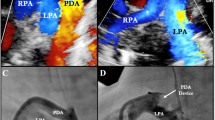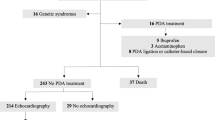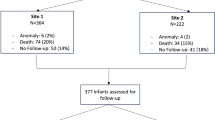Abstract
Objective:
Determine associations between left vocal cord paralysis (LVCP) and poor respiratory, feeding and/or developmental outcomes in extremely low birth weight (ELBW) infants following surgical closure of a patent ductus arteriosus (PDA).
Study Design:
ELBW infants who underwent PDA ligation between January 2004 and December 2006 were identified. We compared infants with and without LVCP following ligation to determine relationships between LVCP and respiratory morbidities, feeding and growth difficulties and neurodevelopmental impairment at 18 to 22-month follow-up. Student's t-test, Fisher's exact test and multivariable regression analyses were used to determine associations.
Result:
In all, 60 ELBW infants with a mean gestational age of 25 weeks and mean birth weight of 725 g had a PDA surgically closed. Twenty-two of 55 survivors (40%) were diagnosed with LVCP post-operatively. Infants with LVCP were significantly more likely to develop bronchopulmonary dysplasia (82 vs 39%, P=0.002), reactive airway disease (86 vs 33%, P<0.0001), or need for gastrostomy tube (63 vs 6%, P<0.0001).
Conclusion:
LVCP as a complication of surgical ductal ligation in ELBW infants is associated with persistent respiratory and feeding problems. Direct laryngoscopy should be considered for all infants who experience persistent respiratory and/or feeding difficulties following PDA ligation.
This is a preview of subscription content, access via your institution
Access options
Subscribe to this journal
Receive 12 print issues and online access
$259.00 per year
only $21.58 per issue
Buy this article
- Purchase on Springer Link
- Instant access to full article PDF
Prices may be subject to local taxes which are calculated during checkout
Similar content being viewed by others
References
Evans N . Diagnosis of patent ductus arteriosus in the preterm newborn. Arch Dis Child 1993; 68: 58–61.
Bancalari E, Claure N, Gonzalez A . Patent ductus arteriosus and respiratory outcome in premature infants. Biol Neonate 2005; 88: 192–201.
Brown ER . Increased risk of bronchopulmonary dysplasia in infants with patent ductus arteriosus. J Pediatr 1979; 95: 865–866.
Dudell GG, Gersony WM . Patent ductus arteriosus in neonates with severe respiratory disease. J Pediatr 1984; 104: 915–920.
Evans N, Moorcraft J . Effect of patency of the ductus arteriosus on blood pressure in very preterm infants. Arch Dis Child 1992; 67: 1169–1173.
Lipman B, Serwer GA, Brazy JE . Abnormal cerebral hemodynamics in preterm infants with patent ductus arteriosus. Pediatrics 1982; 69: 778–781.
Cassady G, Crouse DT, Kirklin JW, Strange MJ, Joiner CH, Godoy G et al. A randomized, controlled trial of very early prophylactic ligation of the ductus arteriosus in babies who weighed 1000 g or less at birth. N Engl J Med 1989; 320: 1511–1516.
Ryder RW, Shelton JD, Guinan ME . Necrotizing enterocolitis: a prospective multicenter investigation. Am J Epidemiol 1980; 112: 113–123.
Lee LC, Tillett A, Tulloh R, Yates R, Kelsall W . Outcome following patent ductus arteriosus ligation in premature infants: a retrospective cohort analysis. BMC Pediatr 2006; 6: 15.
Russell JL, Leblanc JG, Potts JE, Sett SS . Is surgical closure of patent ductus arteriosus a safe procedure in premature infants? Int Surg 1998; 83: 358–360.
Trus T, Winthrop AL, Pipe S, Shah J, Langer JC, Lau GY . Optimal management of patent ductus arteriosus in the neonate weighing less than 800 g. J Pediatr Surg 1993; 28: 1137–1139.
Niinikoski H, Alanen M, Parvinen T, Aantaa R, Ekblad H, Kero P . Surgical closure of patent ductus arteriosus in very-low-birth-weight infants. Pediatr Surg Int 2001; 17: 338–341.
Perez CA, Bustorff-Silva JM, Villasenor E, Fonkalsrud EW, Atkinson JB . Surgical ligation of patent ductus arteriosus in very low birth weight infants: is it safe? Am Surg 1998; 64: 1007–1009.
Zbar RI, Chen AH, Behrendt DM, Bell EF, Smith RJ . Incidence of vocal fold paralysis in infants undergoing ligation of patent ductus arteriosus. Ann Thorac Surg 1996; 61: 814–816.
Rubin AD, Sataloff RT . Vocal fold paresis and paralysis. Otolaryngol Clin North Am 2007; 40: 1109–1131 viii-ix.
Truong MT, Messner AH, Kerschner JE, Scholes M, Wong-Dominguez J, Milczuk HA et al. Pediatric vocal fold paralysis after cardiac surgery: rate of recovery and sequelae. Otolaryngol Head Neck Surg 2007; 137: 780–784.
Daya H, Hosni A, Bejar-Solar I, Evans JN, Bailey CM . Pediatric vocal fold paralysis: a long-term retrospective study. Arch Otolaryngol Head Neck Surg 2000; 126: 21–25.
Davis JT, Baciewicz FA, Suriyapa S, Vauthy P, Polamreddy R, Barnett B . Vocal cord paralysis in premature infants undergoing ductal closure. Ann Thorac Surg 1988; 46: 214–215.
Fan LL, Campbell DN, Clarke DR, Washington RL, Fix EJ, White CW . Paralyzed left vocal cord associated with ligation of patent ductus arteriosus. J Thorac Cardiovasc Surg 1989; 98: 611–613.
Pereira KD, Webb BD, Blakely ML, Cox Jr CS, Lally KP . Sequelae of recurrent laryngeal nerve injury after patent ductus arteriosus ligation. Int J Pediatr Otorhinolaryngol 2006; 70: 1609–1612.
Clement WA, El-Hakim H, Phillipos EZ, Cote JJ . Unilateral vocal cord paralysis following patent ductus arteriosus ligation in extremely low-birth-weight infants. Arch Otolaryngol Head Neck Surg 2008; 134: 28–33.
Malcolm WF, Hornik C, Evans A, Smith PB, Cotten CM . Vocal fold paralysis following surgical ductal closure in extremely low birth weight infants: a case series of feeding and respiratory complications. J Perinatol 2008; 28: 782–785 (in press).
Kuczmarski RJ, Ogden CL, Grummer-Strawn LM, Flegal KM, Guo SS, Wei R et al. CDC growth charts: United States. Adv Data 2000; 314: 1–27.
Bayley N . Manual for the Bayley Scales of Infant Development, second edition. San Antonio: Psychol Corp 1993.
Fanaroff AA, Stoll BJ, Wright LL, Carlo WA, Ehrenkranz RA, Stark AR et al. Trends in neonatal morbidity and mortality for very low birthweight infants. Am J Obstet Gynecol 2007; 196 2: 147 e141-e148.
Chorne N, Leonard C, Piecuch R, Clyman RI . Patent ductus arteriosus and its treatment as risk factors for neonatal and neurodevelopmental morbidity. Pediatrics 2007; 119: 1165–1174.
Kabra NS, Schmidt B, Roberts RS, Doyle LW, Papile L, Fanaroff A . Neurosensory impairment after surgical closure of patent ductus arteriosus in extremely low birth weight infants: results from the Trial of Indomethacin Prophylaxis in Preterms. J Pediatr 2007; 150: 229–234 234 e221.
Farhath S, He Z, Nakhla T, Saslow J, Soundar S, Camacho J et al. Pepsin, a marker of gastric contents, is increased in tracheal aspirates from preterm infants who develop bronchopulmonary dysplasia. Pediatrics 2008; 121: e253–e259.
Davidson BA, Knight PR, Wang Z, Chess PR, Holm BA, Russo TA et al. Surfactant alterations in acute inflammatory lung injury from aspiration of acid and gastric particulates. Am J Physiol Lung Cell Mol Physiol 2005; 288: L699–L708.
Hjalmarson O, Sandberg KL . Lung function at term reflects severity of bronchopulmonary dysplasia. J Pediatr 2005; 146: 86–90.
Rich W, Finer NN, Vaucher YE . Ten-year trends in neonatal assisted ventilation of very low-birthweight infants. J Perinatol 2003; 23: 660–663.
Sachdeva R, Hussain E, Moss MM, Schmitz ML, Ray RM, Imamura M et al. Vocal cord dysfunction and feeding difficulties after pediatric cardiovascular surgery. J Pediatr 2007; 151: 312–315 315 e311-312.
Ellsbury DL, Acarregui MJ, McGuinness GA, Klein JM . Variability in the use of supplemental oxygen for bronchopulmonary dysplasia. J Pediatr 2002; 140: 247–249.
Doyle LW . Evaluation of neonatal intensive care for extremely-low-birth-weight infants. Semin Fetal Neonatal Med 2006; 11: 139–145.
Author information
Authors and Affiliations
Corresponding author
Ethics declarations
Competing interests
The authors declare no conflict of interest.
Rights and permissions
About this article
Cite this article
Benjamin, J., Smith, P., Cotten, C. et al. Long-term morbidities associated with vocal cord paralysis after surgical closure of a patent ductus arteriosus in extremely low birth weight infants. J Perinatol 30, 408–413 (2010). https://doi.org/10.1038/jp.2009.124
Received:
Revised:
Accepted:
Published:
Issue Date:
DOI: https://doi.org/10.1038/jp.2009.124
Keywords
This article is cited by
-
Surgically Acquired Vocal Cord Palsy in Infants and Children with Congenital Heart Disease (CHD): Description of Feeding Outcomes
Dysphagia (2022)
-
Swallow Safety is Determined by Bolus Volume During Infant Feeding in an Animal Model
Dysphagia (2021)
-
Early prediction of spontaneous Patent Ductus Arteriosus (PDA) closure and PDA-associated outcomes: a prospective cohort investigation
BMC Pediatrics (2019)
-
Incidence, Risk Factors, and Comorbidities of Vocal Cord Paralysis After Surgical Closure of a Patent Ductus Arteriosus: A Meta-analysis
Pediatric Cardiology (2019)
-
Surgical Ligation Versus Percutaneous Closure of Patent Ductus Arteriosus in Very Low-Weight Preterm Infants: Which are the Real Benefits of the Percutaneous Approach?
Pediatric Cardiology (2018)



